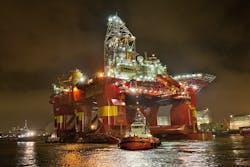Damen Verolme Rotterdam to overhaul Stena Don
Offshore staff
GORINCHEM, the Netherlands– Stena Drilling has contracted Damen Verolme Rotterdam (DVR) for a refit of its semisubmersible drilling rig Stena Don.
The vessel is expected to arrive at DVR in October and remain there for around three months.
DVR will install an eight-point mooring system prior to the rig being deployed off the UK’s Shetland Islands. Preparations are already under way at DVR to ensure that the installation of the mooring system can begin as soon as theStena Don arrives at the yard.
Various elements of the system need to be manufactured. These include the anchor chain blisters and sponsons which, weighing 1,200 metric tons in all, are currently being fabricated at Damen Shipyards Mangalia, ahead of being transferred to Rotterdam.
Other components of the system that are being prepared include eight anchor winches and the fairleads, plus the winch control cabins which will be supplied by Rolls Royce A.S. Modified VFD switchboards and brake resistor units will be delivered by Siemens A.S. The eight ultra-high-holding power anchors are being supplied by Damen Anchor and Chain Factory.
In addition to the mooring system, the yard will also install strengthening to the hull to comply with the new regulations regarding the mitigation of wave impact forces.
TheStena Don, a harsh environment, dynamically-positioned, Class 3 semisub drilling rig, can drill in waters up to 500 m (1,640 ft) deep and has accommodation for 120 personnel. The rig is 95.5 m (313 ft) in length with a beam of 67 m (220 ft). It was built by the Kvaerner Warnow Werft Shipyard in Germany in 2001.
This will be the drilling rig’s fourth visit to the DVR site. Its most recent stopover was in July 2015 when it came in for a special periodical survey and a mid-life upgrade. The eight-point mooring system will enable the rig to operate over a wider range of water depths and remain longer on station than before, particularly in adverse weather conditions, and will make it more fuel efficient by not relying solely on the DPS.
08/02/2018
